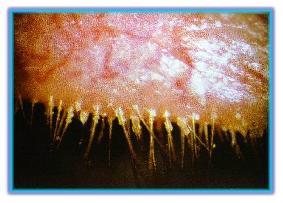| Concomitant involvement
of the sebaceous glands of Zeis produces oily
debris(scurf) along the eyelashes. Foam often accumulates
along the lateral lower eyelid margin. Vascular dilation
with telangiectasia may occur, and the eyelid margins may
be thickened and erythematous. Symptomatic patients complain of chronic
burning, foreign-body sensation, conjunctival redness,
filmy vision, tearing and crusting of the eyelids.
Nonspecific changes of the
ocular surface are produced by the irritating lipids and
secondary tear film abnormalities. Conjunctivitis, and
occusionally episcleritis, occur in chronic cases. The
cornea may be normal, but it sometimes exhibits punctate
epithelial erosions. Marginal subrpithelial infiltrates
and a vascularized pannus can occur with servere disease,
but this is rare.
|
 |

